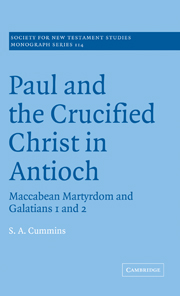Introduction
Published online by Cambridge University Press: 22 September 2009
Summary
By common critical consent Paul's account of, and theological reflection upon, the so-called ‘Antioch incident’ (Galatians 2.11–21) remains a crux interpretum in New Testament studies. The various interrelated problems which it presents are complicated and wide-ranging, not least concerning the reconstruction of both Pauline theology and the development of the early church. Given that this monograph proposes a markedly new approach to this much debated subject, certain preliminary considerations are necessary and will be addressed in this introduction. First, by way of an orientation to the current scholarly state of play, I shall offer a brief outline of certain prominent antecedent evaluations of the Antioch incident, with particular reference to recent developments arising out of the so-called ‘new perspective’ upon Paul as exemplified in the analysis of James D. G. Dunn. In observing various deficiencies and lacunae in these estimations, I also begin to set forth the nature of this enterprise and the manner of its undertaking.
This leads to a second introductory consideration, that of method. Here an attempt is made to explicate and justify what will prove to be a range of new angles on this long-standing issue, some of which are themselves a departure from the current consensus. Foremost among these is the intention to view the Antioch incident within the framework of Maccabean martyrdom.
- Type
- Chapter
- Information
- Paul and the Crucified Christ in AntiochMaccabean Martyrdom and Galatians 1 and 2, pp. 1 - 16Publisher: Cambridge University PressPrint publication year: 2001

